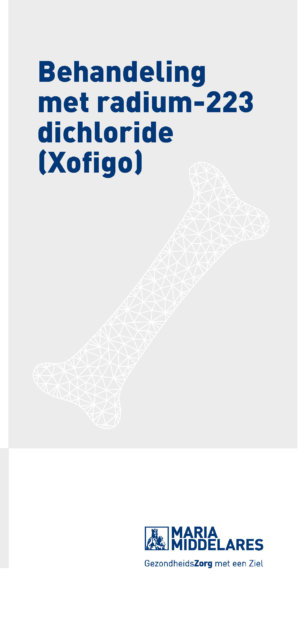Treatment with radium-223 dichloride
What is it?
What is it?Radium-223 dichloride was developed for treating metastases of prostate cancer in the bone. Radium-223 dichloride is administered as an injection in the vein. To achieve an optimal effect with minimal side effects, this is performed six times. The period in between injections is approximately four weeks, depending on your blood tests.
Advantages:
- Prolonged lifespan
- Fewer side effects from cancer in the bone (bone pain, bone fractures)
Care after the treatment
Care after the treatmentContact with pregnant women and small children
Although it is absolutely true that only a very small amount of radiation will be emitted by your body, it may still have an effect on other people in your direct surroundings. For this reason, avoid close and/or prolonged contact with pregnant women and small children for the first seven days after each injection so that they are not unncessarily exposed to radiation.
Preparation for treatment
Drink plenty of fluids before and after each injection.
After the treatment
Most of the injected radioactive substance will be expelled in the stool. A small amount of the radioactive substance will be expelled in the urine. For this reason, take the following hygienic precautions for seven days:
- Urinate in a sitting position or use a urinal to prevent splattering.
- Flush twice after each time you use the toilet.
- For the first seven days after the treatment, only use disposable materials that you can flush down the toilet after using to wipe up spots of bodily fluids (blood, vomit, urine and stool).
- Carefully wash your hands with water and soap each time you use the toilet. All other persons who use the same toilet must also wash their hands after each time and after every time they have contact with the patient's bodily fluids as listed above.
- If you are incontinent, specifically with stool incontinence, use diapers, pads or incontinence underwear that you can flush in the toilet. Dry yourself carefully to prevent contamination.
By following the instructions above, you can minimise radiation exposure to other people. No other precautionary measures are required for the contact you have with other people, including your partner. The only exception is with pregnant women and small children (blue box).
The treatment with radium-223 has no negative influence on your daily activities.
Please inform your attending physician and other physicians involved in your care that you are receiving treatment with radium-223. With this information, you can decide which treatment is the most appropriate for you. Show your treament card to all physicians and nurses who are involved in your care. This card contains all contact information for your nuclear medicine specialist and help other physicians or governmental institutions ask necessary questions (with your permission).
Contraception
There is no information available regarding the possibility of small quantities of radioactivity being transferred during intercourse after having received an injection with radium-223. For this reason, a condom must be used for the first seven days after each injection. In order to limit the risk of modification to stem cells caused by radiation, you may not get pregnant either during the treatment or up to six months after the last administered treatment. During this period, you and/or your partner must always use a reliable contraceptive method (pill, IUD, condom, etcetera).
Possible side effects
Possible side effectsThe most common side effects:
- Diarrhoea
- Nausea
- Vomiting
- Reduced number of blood cells that play a role in coagulation (e.g. hrombocytopenia)
Less common side effects:
- Reaction to the injection site, such as redness, pain or swelling.
- Reduced number of white blood cells that play a role in immunity.
- Reduced number of red blood cells, which may result, among other things, in fatigue and/or pale skin
- The two points above and thrombocytopenia
Leaflet
LeafletOnly available in Dutch:

Behandeling met radium-223 dichloride (Xofigo)
DownloadCentres and specialist areas
Centres and specialist areas
Something wrong or unclear on this page? Report it.
Latest publication date: 13/08/2024
Supervising author: Dr Van Den Bossche Bieke




